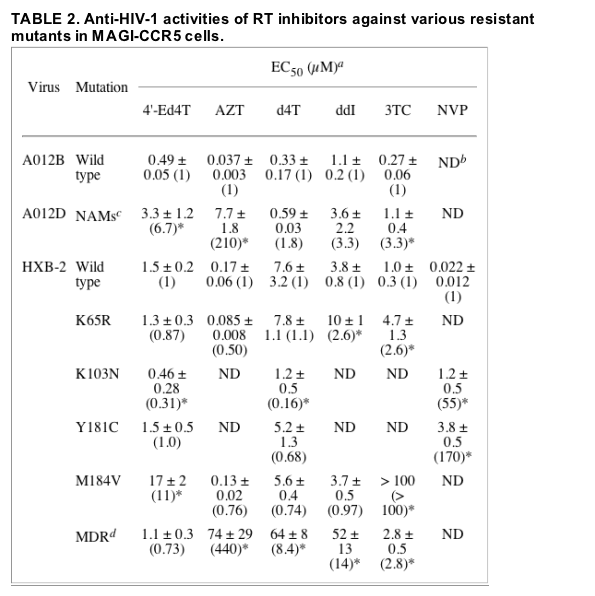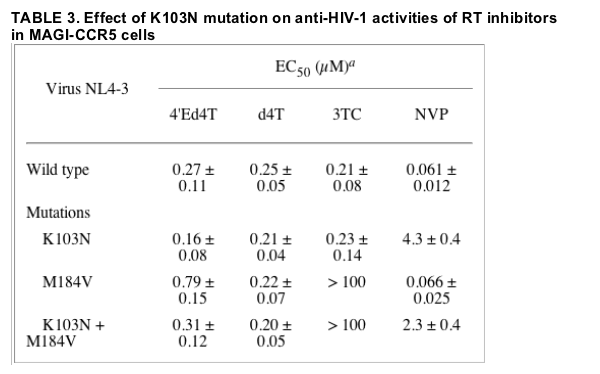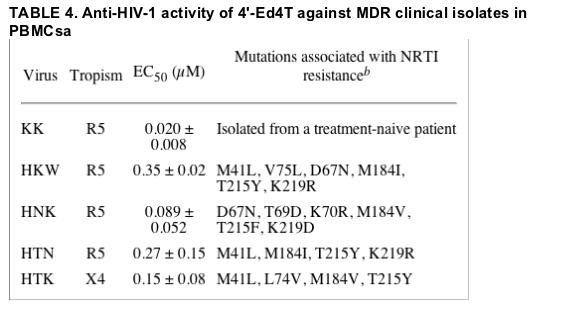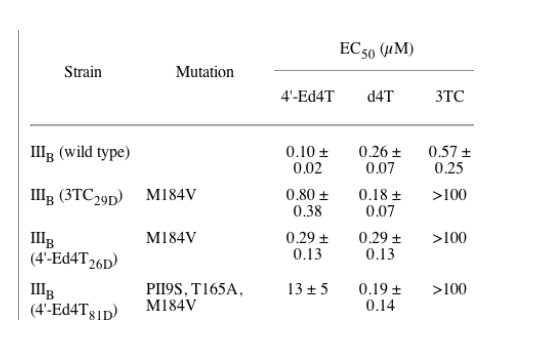| |
New d4T-like NRTI Potent vs NRTI Resistant HIV
|
| |
| |
"Novel Anti-HIV Agent Shows Unique Resistance Profile"
NEW YORK (Reuters Health) Aug 29 - A new nucleoside reverse transcriptase inhibitor (NRTI) has a resistance profile different from stavudine (d4T), to which it is structurally related, as well as from other NRTIs currently in use, a new study shows.
The compound, 4'-Ed4T, already has been shown to be more potent and less toxic than d4T, Dr. Masanori Baba of Kagoshima University in Japan and colleagues report. Based on their current findings, as well as the compound's favorable oral bioavailability in rodents, the researchers have launched toxicity tests of 4'-Ed4T in animals.
In the August issue of Antimicrobial Agents and Chemotherapy, Dr. Baba and his team report on their tests of the effects of 4'-Ed4T against several reverse transcriptase inhibitor-resistant HIV-1 mutations. The researchers also confirmed that 4'-Ed4T was roughly four times more potent than d4T, and less cytotoxic.
Four NRTI-linked mutations, as well as the lamivudine (3TC)-associated mutation M184V, increased HIV susceptibility to 4'-Ed4T by 6- to 11-fold, the researchers found. Multidrug-resistant strains were 4.5- to 17.5-fold less susceptible to 4'-Ed4T than an isolate from a treatment nave patient, they report, but still inhibited the drug-resistant strains at low concentrations.
The presence of the K65R mutation or the Q151M complex, which confers multidrug resistance, did not change susceptibility to 4'-Ed4T, while strains with the nonnucleoside reverse transcriptase inhibitor (NNRTI) resistance mutation K103N showed increased susceptibility to 4'-Ed4T.
"This nature of 4'-Ed4T seems beneficial, since many HIV-1 infected individuals are currently treated with a 3TC- and NNRTI-containing regimen," Dr. Baba and his team write.
The researchers also maintained HIV-infected cells in culture long-term with 4'-Ed4T to predict the development of drug resistant mutations. Strains with the M184V mutation showed resistance to 3TC and some degree of resistance to 4'-Ed4T, the researchers found, but at least one additional mutation appeared necessary for a strain to become substantially resistant to the drug.
"Since 4'-Ed4T has increased anti-HIV activity, decreased cytotoxicity, and a different resistance profile, it should be considered for further development as a new member of NRTIs," the researchers conclude.
Antimicrob Agents Chemother 2005;49:3355-3359.
Anti-Human Immunodeficiency Virus Type 1 Activity and Resistance Profile of 2',3'-Didehydro-3'-Deoxy-4'-Ethynylthymidine In Vitro
Antimicrobial Agents and Chemotherapy, August 2005, p. 3355-3360, Vol. 49, No. 8
Takao Nitanda,1 Xin Wang,1 Hiroki Kumamoto,2 Kazuhiro Haraguchi,2 Hiromichi Tanaka,2 Yung-Chi Cheng,3 and Masanori Baba1*
Division of Antiviral Chemotherapy, Center for Chronic Viral Diseases, Graduate School of Medical and Dental Sciences, Kagoshima University, Kagoshima 890-8544,1 School of Pharmaceutical Sciences, Showa University, Tokyo 142-8555, Japan,2 Department of Pharmacology, School of Medicine, Yale University, New Haven, Connecticut 065203
ABSTRACT
2',3'-Didehydro-3'-deoxy-4'-ethynylthymidine (4'-Ed4T) has been identified as a novel nucleoside analog with potent and selective anti-human immunodeficiency virus type 1 (HIV-1) activity and weak cytotoxicity in cell cultures. 4'-Ed4T proved to be 5- to 10-fold more active than its structurally related compound, stavudine (d4T). However, the drug resistance profile of 4'-Ed4T was different from those of d4T and other existing HIV-1 nucleoside reverse transcriptase inhibitors (NRTIs). Approximately 6- to 11-fold decreases in susceptibility to 4'-Ed4T were observed for HIV-1 carrying NRTI-associated mutations (D67N, K70R, T215F, and K219Q) or the lamivudine (3TC)-resistant mutation M184V. In contrast, the susceptibility of the virus carrying the K65R mutation or the multidrug-resistant mutation with the Q151M complex (A62V, V75I, F77L, F116Y, and Q151M) was not altered. Furthermore, the activity of 4'-Ed4T appeared to be enhanced in the presence of K103N, a major nonnucleoside reverse transcriptase inhibitor-resistant mutation. Although 4'-Ed4T was 4.5- to 17.5-fold less active against multidrug-resistant clinical isolates than against a reference strain isolated from a treatment-naïve patient, it was still inhibitory to these isolates at low concentrations. Analysis of 4'-Ed4T-resistant HIV-1 obtained through in vitro selection revealed that the virus was also resistant to 3TC and had two amino acid mutations (P119S and T165A) in addition to the M184V mutation. Since 4'-Ed4T has increased anti-HIV-1 activity, decreased cytotoxicity, and a different resistance profile, it should be considered for further development as a new member of NRTIs.
Extracted Article Text
Our continuous efforts to search for novel NRTIs with potent anti-HIV-1 activity, low toxicity, and a lack of cross-resistance to existing anti-HIV-1 agents have recently identified the 4'-substituted nucleoside analog 2',3'-didehydro-3'-deoxy-4'-ethynylthymidine (4'-Ed4T). 4'-Ed4T is structurally related to d4T (Fig. 1). It was recently found to be more active against HIV-1 replication and much less inhibitory to mitochondrial DNA synthesis in cell cultures than d4T (13). Furthermore, 4'-Ed4T displayed synergistic anti-HIV-1 activity, when combined with 3TC or FTC. In this study, we have examined 4'-Ed4T for its inhibitory effect on a variety of reverse transcriptase (RT) inhibitor-resistant mutants, including multidrug-resistant clinical isolates, and found that the antiviral profile of 4'-Ed4T against the resistant mutants is mostly different from that of d4T.
4'-Ed4T was synthesized according to the synthetic method, as previously described (16). AZT, d4T, and ddI were purchased from Sigma Chemical Co. (St. Louis, MO). 3TC and NVP were synthesized and kindly provided by Mitsubishi Chemical Corporation (Yokohama, Japan). These compounds were dissolved in dimethyl sulfoxide at a concentration of 20 mM or higher to avoid any cytotoxicity of dimethyl sulfoxide.
RESULTS
Anti-HIV-1 activity of 4'-Ed4T.
When 4'-Ed4T, d4T, and 3TC were examined for their inhibitory effects on HIV-1 replication in MT-4 cells, 4'-Ed4T was found to be the most active among the three compounds (Table 1). The 50% effective concentrations (EC50s) of 4'-Ed4T, d4T, and 3TC were 0.070, 0.31, and 0.60 mM, respectively, indicating that 4'-Ed4T was approximately fourfold more potent than the parental compound d4T. This result correlated well with our previous result in MT-2 cells, although the EC50s of both compounds tended to be higher in MT-2 cells than those in MT-4 cells. 4'-Ed4T proved highly active against both X4 and R5 laboratory-adapted HIV-1 strains (IIIB and Ba-L, respectively) in PBMCs (Table 1). The EC50s against the IIIB and Ba-L strains were 0.0019 and 0.0076 mM, respectively. These values were 6- to 10-fold lower than those of d4T. On the other hand, 4'-Ed4T was less cytotoxic than d4T in mock-infected MT-4 cells and PBMCs. The 50% cytotoxic concentrations (CC50s) of 4'-Ed4T and d4T were >100 and 79 mM, respectively, in MT-4 cells and 56 and 28 mM, respectively, in PBMCs. These results suggest that 4'-Ed4T is a more potent and selective inhibitor of HIV-1 replication in vitro than d4T.
Activity of 4'-Ed4T against RT inhibitor-resistant mutants. 4'-Ed4T and other RT inhibitors were examined for their inhibitory effects on various RT inhibitor-resistant mutants in MAGI-CCR5 cells. Table 2 shows the EC50s of five NRTIs, including 4'-Ed4T, and one NNRTI against six RT inhibitor-resistant mutants as well as two corresponding wild-type strains. Table 2 also displays the fold increase in EC50s against the mutants, based on the EC50 values. The A012D contains four of the NRTI-associated mutations (NAMs), such as D67N, K70R, T215F, and K219Q, and was previously reported as an AZT-resistant strain (23). In fact, A012D was highly resistant to AZT and approximately 210-fold less susceptible than its wild-type A012B. 4'-Ed4T was found to be 6.7-fold less active against A012D than against A012B. Interestingly, the anti-HIV-1 activity of 4'-Ed4T was not affected by the K65R mutation and the multidrug-resistant (MDR) mutation Q151M complex (A62V, V75I, F77L, F116Y, and Q151M). The K65R mutation is known to confer resistance to tenofovir (TFV) and some other NRTIs (28, 31, 39), while the Q151M complex is able to confer resistance to most of the clinically licensed NRTIs (35). In fact, a considerable decrease in anti-HIV-1 activity was observed for AZT, d4T, and ddI against the Q151M complex strain (Table 2).

Another interesting finding is that the anti-HIV-1 activity of 4'-Ed4T was weakened by the M184V mutation, which confers a high level of resistance to 3TC (Table 2). An approximately 11-fold decrease in anti-HIV-1 activity was observed for 4'-Ed4T against the M184V mutant of the HXB-2-based molecular clone, although the degree of reduced activity was not comparable to that of 3TC (Table 2). Furthermore, the K103N mutation, which confers a high level of resistance to NNRTIs, appeared to increase the susceptibility to 4'-Ed4T and d4T. To confirm this observation, the NL4-3-based molecular clones carrying the mutation(s) of K103N alone, M184V alone, and both were examined for their susceptibility to 4'-Ed4T, d4T, 3TC, and NVP in MAGI-CCR5 cells. Again, moderate decrease and increase in the activity of 4'-Ed4T were observed against the M184V and K103N mutants, respectively (Table 3). However, different from the observation with the HXB-2-based molecular clones, the anti-HIV-1 activity of d4T was unaffected irrespective of the absence or presence of the K103N mutation. Although the K103N and M184V mutations seem to independently affect the activity of 3TC and NVP, the EC50 of 4'-Ed4T against the double (K103N + M184V) mutant resulted in being similar to that against the wild type(table 3).

Activity of 4'-Ed4T against drug-resistant clinical isolates.
In the next experiment, 4'-Ed4T was examined for its inhibitory effect on the replication of four multidrug-resistant clinical isolates in PBMCs. The KK strain isolated from a treatment-naïve patient was used as a reference strain. The NRTI-associated mutations of the clinical isolates used in this study are listed in Table 4. In addition to these mutations, these strains showed considerable resistance to NNRTIs (NVP and EFV) and several PIs (Dr. Oka, personal communication). As shown in Table 4, 4'-Ed4T proved highly active against the KK strain, which does not carry known NRTI-associated amino acid mutations (data not shown), with an EC50 of 0.020 mM. The anti-HIV-1 activity of 4'-Ed4T appeared to be somewhat reduced against the four clinical isolates compared to the KK strain. Its EC50s for these clinical isolates ranged from 0.089 to 0.35 mM (Table 4).

Susceptibility and amino acid mutations of 4'-Ed4T-resistant virus. After a serial passages of the infected MT-4 cells in the presence of increasing concentrations of 4'-Ed4T or 3TC, breakthrough viruses were obtained in the presence of 20 mM 3TC on day 29 and 2 mM 4'-Ed4T on day 81 after virus infection (Fig. 2). When the breakthrough viruses as well as the parental IIIB strain were examined for their susceptibility to 4'-Ed4T, d4T, and 3TC, the breakthrough viruses in the presence of either 3TC [IIIB (3TC29D)] or 4'-Ed4T [IIIB (4'-Ed4T26D) and IIIB (4'-Ed4T81D)] were completely resistant to 3TC (Table 5). 3TC could not inhibit the replication of these viruses at concentrations up to 100 mM. In contrast, d4T was equally inhibitory to IIIB, IIIB (3TC29D), IIIB (4'-Ed4T26D), and IIIB (4'-Ed4T81D). 4'-Ed4T was found to be 8-, 2.9-, and 130-fold less active against IIIB (3TC29D), IIIB (4'-Ed4T26D), and IIIB (4'-Ed4T81D), respectively, compared with the wild type. Analysis for RT amino acid mutations revealed that IIIB (3TC29D) and IIIB (4'-Ed4T26D) had one amino acid mutation, M184V, while an additional two mutations, P119S and T165A, were identified in the RT of IIIB (4'-Ed4T81D). These results suggest that the M184V mutation confers some resistance to 4'-Ed4T, yet additional mutations are required for HIV-1 to obtain a high level of resistance to 4'-Ed4T.
TABLE 5. Anti-HIV-1 activities of 4'Ed4T, d4T, and 3TC against 3TC- and 4'Ed4T-resistant IIIB strains in MT-4 cellsa

DISSCUSION
The anti-HIV-1 activities of 4'-substituted nucleoside analogs have been synthesized and examined for their antiviral activities. Among the compounds, 4'-azidothymidine (4'-AZT) and 4'-methoxythymidine were reported to inhibit HIV-1 replication in vitro (26). More recently, a series of 4'-ethynyl nucleoside analogs has been identified as highly potent and selective inhibitors of HIV-1 replication (20). These analogs were not further investigated for their clinical potential as novel antiretroviral agents because of their toxicity in vivo. They had the 2'-deoxyribose configuration instead of 2',3'-dideoxyribose configuration. It is possible that the compounds are recognized as a substrate by cellular DNA polymerases and incorporated into the host DNA due to the presence of a hydroxy group at the 3' position (10). To circumvent the interaction with cellular DNA polymerases, 4'-substituted 2',3'-dideoxynucleoside analogs have been designed and examined for their anti-HIV-1 activity. However, removal of the 3'-hydroxy group (2',3'-dideoxy and 2',3'-didehydro-2',3'-dideoxy configurations) in 4'-substituted nucleosides resulted in complete loss of the antiviral activity (26).
During our investigations on the reaction of organometallic reagents with 4',5'-epoxy nucleosides, we have established the synthesis of 4'-substituted d4T derivatives and examined them for their anti-HIV-1 activity (16, 17). To our surprise, 4'-Ed4T and 4'-cyano-d4T proved to be highly potent inhibitors of HIV-1 replication in cell cultures. 4'-Ed4T was more active against laboratory-adapted HIV-1 strains in T-cell lines and PBMCs and less cytotoxic to the host cells than d4T (Table 1). The ideal NRTI must be recognized by host cellular kinases and converted to its 5'-triphosphate form with high efficiency. In addition, the nucleoside 5'-triphosphate must interact preferentially with HIV-1 RT but not with cellular DNA polymerases. Toxicity of NRTIs may be related to inhibition of mitochondrial DNA polymerase {gamma} (1). In fact, our previous study clearly showed that the efficiency of human thymidine kinase in the phosphorylation of 4'-Ed4T was fourfold better than that of d4T (13). The study also demonstrated that 4'-Ed4T did not affect the mitochondrial DNA synthesis in the human T-cell line CEM at concentrations up to 100 mM, whereas d4T and zalcitabine reduced its mitochondrial DNA content by 50% at concentrations of 9.3 and 0.15 mM, respectively. Although the direct inhibition of human DNA polymerase {gamma} by the 5'-triphosphate form of 4'-Ed4T (4'-Ed4T-TP) remains to be examined, 4'-Ed4T-TP may not be a good substrate of this enzyme. Furthermore, it is hardly conceivable that 4'-Ed4T is converted to d4T during its metabolic process and that one of its metabolites acts as an NNRTI, since this compound was also active against simian immunodeficiency virus replication (data not shown).
In this study, we have examined the anti-HIV-1 activity of 4'-Ed4T against a variety of NRTI-resistant strains, including clinical isolates, to elucidate the resistance profiles of this compound and obtained several interesting findings (Tables 2 and 3). First, a moderate decrease in susceptibility to 4'-Ed4T was observed for the mutant carrying NAMs. Second, a moderate decrease in susceptibility was also observed for the 3TC-resistant (M184V) mutant. Third, the susceptibility of the mutants carrying K65R or the Q151M complex was not altered. Fourth, the activity of 4'-Ed4T appeared to be enhanced in the presence of the NNRTI resistance mutation K103N. These results suggest that 4'-Ed4T has different drug resistance profiles. The molecular mechanism of the enhanced activity of 4'-Ed4T against the K103N mutant is unclear and an important subject to be determined. From a practical point of view, this nature of 4'-Ed4T seems beneficial, since many HIV-1-infected individuals are currently treated with a 3TC- and NNRTI-containing regimen. Thus, a certain proportion of such individuals may carry the double (K103N + M184V) mutants after long-term treatment (11).
To predict the emergence of drug-resistant mutants in vivo, a long-term culture experiment with HIV-1-infected cells in the presence of 4'-Ed4T was conducted. Analysis for the amino acid sequences in the RT of breakthrough viruses revealed that the M184V mutation conferred a modest degree of resistance to 4'-Ed4T (Table 5). However, unlike 3TC, an additional mutation (either P119S or T165A) or even both mutations may be required for a high level of resistance to 4'-Ed4T, since the intermediate breakthrough virus [IIIB (4'-Ed4T26D)] obtained on day 26 in the presence of 4'-Ed4T was found to have only the M184V mutation and retain considerable susceptibility to 4'-Ed4T (Fig. 2 and Table 2). Tanaka et al. reported that the P119S mutation conferred resistance to 2'-ß-fluoro-2',3'-deoxyadenosine (F-ddA) (38). Although an additional two mutations (V179D and L214F) were frequently associated with this mutation, the P119S mutation proved to be directly responsible for the reduced susceptibility of HIV-1 to F-ddA. They assumed that the additional mutations compensated for the reduction in viral replication capacity (fitness) brought about by the P119S mutation. It could be possible that one of P119S and T165A mutations could enhance the resistance of M184V mutants to 4'-Ed4T and that the other could improve viral fitness. Further experiments, such as susceptibility tests of infectious molecular clones with either the P119S or T165A mutation, are required to clarify the role of each mutation.
In conclusion, 4'-Ed4T is a novel nucleoside analog with a unique chemical structure. The compound is a potent and selective inhibitor of HIV-1 replication and is less cytotoxic to the host cells than d4T in vitro. 4'-Ed4T also shows a unique drug resistance profile that clearly differs from that of known NRTIs. Since 4'-Ed4T has favorable oral bioavailability in mice (unpublished data), toxicity tests in animals have been initiated for further evaluation of its potential as an anti-HIV-1 agent.
|
|
| |
| |
|
|
|